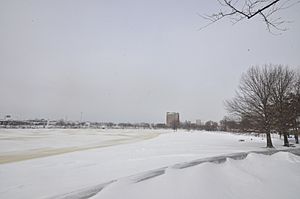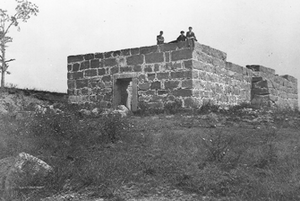Magazine Beach facts for kids
Magazine Beach is a fun riverside park located in Cambridge, Massachusetts. It sits right next to the Charles River, across from the neighborhood of Cambridgeport. On the other side of the river, you can see parts of Boston University.
This park is one of the biggest in Cambridge, covering about 15 acres (6.1 hectares). It stretches along the river from Pleasant Street all the way to the BU Bridge. At Magazine Beach, you'll find a free outdoor swimming pool called Veteran's Memorial Pool. There are also sports fields, exercise equipment, and nice spots for picnics. The Paul Dudley White Bike Path goes right through the park, perfect for biking or walking.
The park is named after an old building called a gunpowder magazine from 1818. This building was used to store gunpowder safely. It's the oldest building in the entire Charles River Reservation area. Long ago, in the early to mid-1900s, Magazine Beach even had a swimming area in the Charles River. About 60,000 people would come to swim each season! However, swimming in the river became unsafe because of pollution, so it was stopped in 1949.
Contents
History of Magazine Beach
From Wild Lands to Captain's Island
Before European settlers arrived, the area where Magazine Beach is now was a wild, wooded place. It was a mix of land and water, like a marshy forest near the river.
In the 1600s, the Massachusetts Bay Colony gave land to a soldier named Captain Daniel Patrick. He was asked to build forts and train soldiers to protect the area. One piece of land he received was called Captain's Island. This wasn't a true island surrounded by open water. Instead, it was a small hill of dry land surrounded by wet marshes. People likely built a simple watchpost there to keep an eye on things.
The Powder Magazine Building
Before the American Revolution, Captain's Island was owned by Charles Ward Apthorp. He was a Loyalist, meaning he supported the British during the war. After the Revolution, his land was taken by the new American government. In 1787, it was sold to William Whittemore.
Later, in 1802, Whittemore sold the island to Francis Dana. In 1818, Dana's family sold the island to the state of Massachusetts. The state wanted to build a powder magazine there. This was a special building designed to store gunpowder safely. Building the powderhouse cost about $11,020 back then.
By 1863, the powderhouse was still in use but was starting to show its age. That same year, the state closed it down. More and more homes were being built nearby, and it was too dangerous to have a gunpowder storage building so close to people. Over the next few decades, the building slowly became a ruin.
Creating a Public Park and Beach
In the 1890s, going to public beaches became very popular in the United States. In 1894, the City of Cambridge took over the land where the powderhouse was. They started turning it into a park.
Under the guidance of the Olmsted Brothers, who were famous landscape designers, the marshy land was filled in. This made Captain's Island part of the mainland. The riverfront was shaped into a sandy beach. The old powderhouse was changed into a bathhouse for swimmers. This involved many big changes to the building. In 1918, the city spent $3,000 to fix up the bathhouse. In the early to mid-1900s, many factory workers, including immigrants, lived in Cambridgeport. The beach was a very popular spot for them to cool off and relax.
In 1912, the Riverside Boat Club built its new boathouse near the park. This area was once muddy flats but is now part of Magazine Beach Park.
In 1921, the land was given to the Massachusetts District Commission. This group was in charge of parks and recreation. In 1949, they officially banned swimming in the Charles River because of pollution. In 1954, the old powderhouse was changed again, this time into a garage and office. But it slowly stopped being used.
A large six-lane highway called the Inner Belt was once planned to go right through Magazine Beach. This would have destroyed the park. But after many strong protests, the project was canceled in 1971.
Magazine Beach in the 21st Century
In the early 2000s, Magazine Beach received many updates and improvements. The park was closed for some time while this work was done, and it reopened in the summer of 2020.
New features added to the park include a place to launch canoes and kayaks. There's also a splash deck where kids can play in the water. The path along the riverside was made wider for walkers and bikers. The old powderhouse building was fixed up, and new benches and sitting areas were built around it. However, at that time, the inside of the building had not yet been restored for public use.
There's also an exciting idea for a much larger park along both sides of the Charles River. This plan would include a new area called Allston Landing on the opposite bank. Footbridges would connect this new area to Magazine Beach Park.
Images for kids







